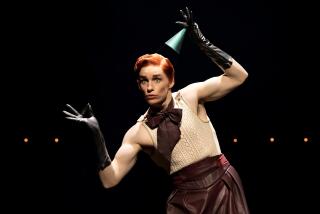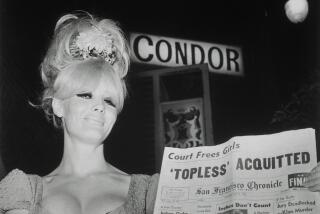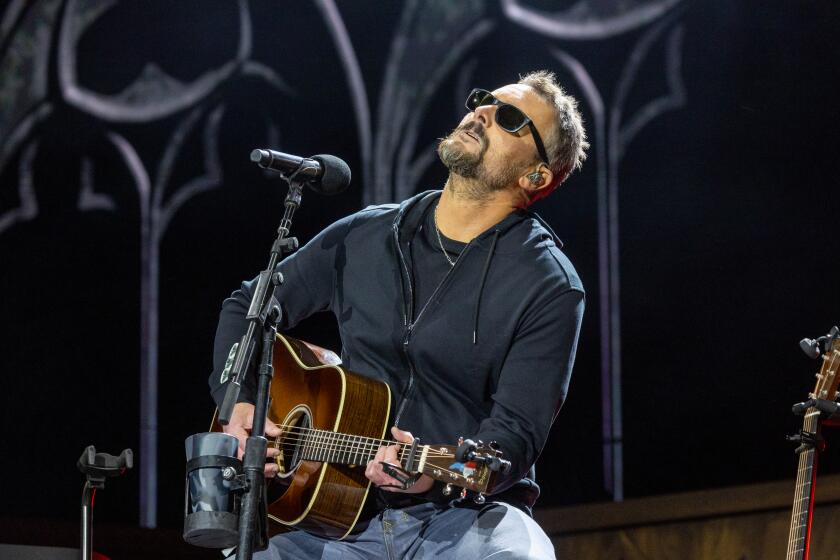Critic’s Notebook: Yuja Wang, dressed to kill
In 1967, video artist, composer and conceptualist Nam June Paik caused a minor sensation with his “Opera Sextronique.” It called for cellist Charlotte Moorman to undress during the performance, which seemed fine for Europe and Philadelphia. But the New York premiere was stopped by the police, and Paik and Moorman were hauled off in handcuffs.
At her trial, the judge asked Moorman, who became known as “the topless cellist,” if she had attempted to give a cello concert. Yes, she said. Was she Pablo Casals? No, your honor. In that case, the court found her guilty of indecent exposure.
“The theory that the artist must dress in the costume of his trade is one of the heaviest burdens the arts have to carry,” the New York Times columnist Russell Baker wrote in response, “and it is sad to see the judiciary fumble an opportunity to free them of it.”
The pianist Yuja Wang broke no public decency laws when she appeared as soloist in Rachmaninoff’s Piano Concerto No. 3 at the Hollywood Bowl in a little orange dress two weeks ago. But from the response of the audience (gasps, wolf whistles and popping flashes) and the heated reactions to my descriptions of the concert that have been percolating through the blogosphere, the burden has not been lifted.
The dress was short, tight and stylish. Wang’s heels were high. She’s 24, and she’s had fashion magazine spreads. Had she walked the Academy Awards red carpet in this outfit, she would have been noticed. She looked great.
She also played impressively under the circumstances, those circumstances being a Bowl schedule (usually a single morning rehearsal) that offers barely enough time to work out basic coordination with the orchestra, and none for nuance. Her heels didn’t hurt her pedaling. Her fingers flew across the keyboard with startling speed, power and accuracy in a concerto notorious for its technical challenges. If she showed off, it was with her cocky coolness. But, then, it used to be considered, in less showboating days, that the mark of a true virtuoso was someone who, as Wang did, made the difficult look easy.
So what’s the big deal? Partly, it was the surprise. When Wang played with the Los Angeles Philharmonic two years ago, she wore a long red gown that was very nice but also traditional. As recently as last June, I saw Wang with the San Francisco Symphony in a long blue gown.
The classical music dress code has loosened up over the years. In opera productions that would make “Opera Sextronique” look tame, star singers are regularly expected to wear (and sometimes remove) revealing costumes on even the most respectable of Old World stages. In the Gaga pop world, Wang’s orange dress would not have raised a plucked, pierced, tattooed eyebrow other than for its tastefulness. Still, for a Bowl concert, Wang did go as far as a classical performer could without appearing risqué. At intermission there was a certain amount of tsk, tsk-ing from the wolf-whistlers’ wives.
The fact is, we don’t ignore appearance, and we never have. Liszt’s long hair and Paganini’s spectral manner helped make them music’s first rock stars. Beethoven’s dishevelment was, some Viennese thought, reflected in his incomprehensible late music. Everyone noticed that Glenn Gould sat on a rickety low chair. Carlo Maria Giulini’s elegant posture and Armani suits added to his image, as Anne Sophie Mutter’s strapless gowns have to hers.
Unlike when listening in an iPod cocoon, we use all our senses at a concert. We see, we smell, we feel heat and cold, we are aware of many different sounds besides those of the performance. It’s all music. A musician’s instrument, moreover, is an extension of the player’s body. That was at least some of Moorman’s point. So yes, appearance always matters, a performer is a performer. What is worn is simply part of the show.
At the Bowl, the environment and appearance can even dominate music. A supersized McMansion shell now dwarfs the players (the older shell was on a more human scale), and it is flanked by two gigantic video screens. We are no longer meant to watch the stage, but to watch TV. Wang, it must be remembered, was shown greatly magnified in close-up. And she was heard through a sound system, which could use an upgrade, that also contributes to the artificially cinematic nature of these concerts.
Many bloggers have been weighing in on the appropriateness of discussing Wang’s appearance as well as her playing. For some reason, bringing the real world into the classical music realm has seemed somehow inappropriate. And what strange red flags an orange dress raised. An NPR blog thought me contemptuous of Wang (hardly). Others thought me too concerned with her looks. People read into this whatever they like.
But this was no conventional concert hall event. The New York Post might have found a headline for an evening when the audience watched cameras salaciously focus in on a sexy pianist, “A Dish for the Bowl.”
Watch, the audience most certainly did. More and more often, picnickers in the Bowl’s box section barely bother to turn their chairs around to face the stage during performances, dining, instead, with background music. Others spend their time playing with their distracting cellphones.
Not this time. All eyes were on Wang. And when the cameras got enough of her legs and showed her fingers, there was a noticeable collective concentration on the music, and more gasps and bursts of applause at crazy hard passages. In the end, Wang managed to make her dress serve the music, and that’s something.
One can only imagine what sextronique shenanigans the late Paik, who also designed a “TV bra” for Moorman, might have come up with on this current Bowl setup.
More to Read
The biggest entertainment stories
Get our big stories about Hollywood, film, television, music, arts, culture and more right in your inbox as soon as they publish.
You may occasionally receive promotional content from the Los Angeles Times.







